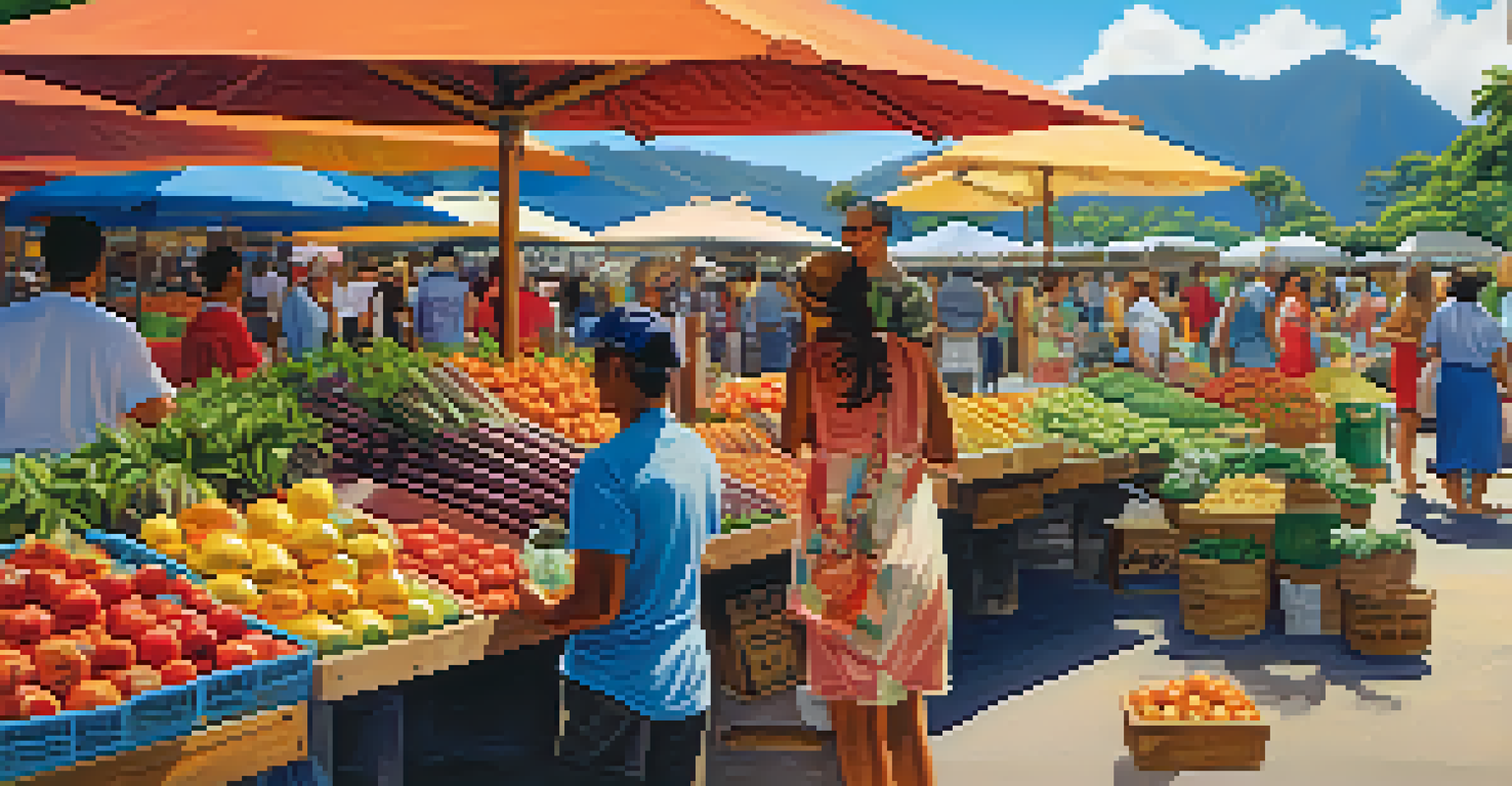The Influence of Global Events on Hawaii's Tourism Trends

Understanding Hawaii's Unique Tourism Market
Hawaii's tourism market is unique due to its isolation and natural beauty. This picturesque paradise draws millions of visitors each year, eager to experience its stunning beaches and rich culture. The appeal of Hawaii often lies in its promise of relaxation and adventure, making it a prime destination for travelers from all over the world.
Hawaii's beauty is a treasure that must be preserved, not just for visitors but for future generations to enjoy.
However, this market is not immune to global events that can shift tourism trends. Economic downturns, natural disasters, and even political unrest in other parts of the world can have significant ripple effects on Hawaii's tourism. Understanding these dynamics is crucial for stakeholders in the tourism industry to adapt and thrive.
For instance, when global economies falter, luxury travel often declines, causing a shift in visitor demographics. This leads to an increased focus on budget-friendly options and local experiences, which can redefine what tourism looks like in Hawaii.
Effects of Global Pandemics on Visitor Numbers
The COVID-19 pandemic dramatically altered travel patterns and tourism in Hawaii. With restrictions on international travel and health concerns, the number of visitors plummeted, leading to a significant economic impact on the islands. This unprecedented situation forced many businesses to adapt or face closure, reshaping the tourism landscape.

During this time, Hawaii pivoted to promote local tourism, encouraging residents to explore their own islands and support local businesses. This move not only helped sustain the economy but also fostered a deeper appreciation for Hawaii’s natural beauty among locals. As travel restrictions eased, these changes set the stage for a new form of tourism that prioritizes sustainability and community engagement.
Tourism Trends Shift with Global Events
Hawaii's tourism market adapts to global events, such as economic downturns and pandemics, influencing visitor demographics and preferences.
As the world begins to recover, the lessons learned during the pandemic will likely influence how Hawaii markets itself. Emphasizing health, safety, and eco-friendly practices could become essential elements in attracting visitors.
Impact of Climate Change on Travel Patterns
Climate change is a pressing global issue that significantly influences tourism trends in Hawaii. The islands are experiencing rising sea levels, increased storm intensity, and changing weather patterns, which can deter potential visitors. Tourists are becoming more conscious of environmental factors, seeking destinations that prioritize sustainability.
Travel is about more than just the destination; it's about the journey, the experiences, and the connections we make along the way.
Hawaii's natural beauty is a major draw, but the threat of climate change can push travelers to reconsider their plans. For example, areas heavily affected by erosion or coral bleaching may see a decline in visitors, prompting local businesses to rethink their offerings. The islands are now faced with the challenge of balancing tourism and preservation.
In response, many Hawaiian businesses are adopting sustainable practices to attract eco-conscious travelers. By promoting responsible tourism initiatives, Hawaii aims to showcase its commitment to preserving its unique environment while continuing to welcome tourists.
Global Economic Trends and Their Effects
Global economic trends directly impact Hawaii's tourism, as fluctuations in currencies can influence travel affordability. When the U.S. dollar is strong, international travelers may find Hawaii to be a more expensive destination, potentially reducing the number of visitors from countries with weaker currencies. Conversely, a weaker dollar can attract more international tourists looking for better value.
Economic stability in key markets, such as Japan and Canada, also plays a vital role in determining visitor numbers. For instance, during economic booms, more travelers are likely to splurge on vacations, including trips to Hawaii. This can lead to a surge in demand for accommodations and experiences, prompting businesses to scale up their operations.
Climate Change Challenges Tourism
Rising sea levels and changing weather patterns are prompting Hawaii to adopt sustainable practices to attract eco-conscious travelers.
Understanding these economic nuances helps Hawaii's tourism stakeholders anticipate changes in visitor demographics and spending habits. By adjusting marketing strategies accordingly, they can better position Hawaii as an attractive destination during various economic climates.
Political Stability and Travel Confidence
Political stability is a crucial factor that impacts travel confidence and tourism trends in Hawaii. Global events, such as elections, conflicts, or diplomatic tensions, can create uncertainty for potential travelers. When people feel uncertain about their safety or the political climate of a region, they are less likely to book trips, especially to far-flung destinations like Hawaii.
For instance, during times of unrest in other parts of the world, Hawaii may benefit from being perceived as a safe and stable travel destination. This can lead to an influx of visitors seeking a reprieve from global tensions. Conversely, if a major event occurs that raises safety concerns, even Hawaii can see a decline in travel interest.
To combat this, Hawaii's tourism boards often emphasize its safety measures and promote the islands as a peaceful getaway. This proactive approach helps maintain traveler confidence and encourages potential visitors to choose Hawaii as their destination.
The Role of Social Media in Shaping Trends
In today's digital age, social media plays a crucial role in shaping tourism trends, including those in Hawaii. Platforms like Instagram and TikTok showcase the stunning landscapes and unique experiences that the islands offer, captivating potential travelers. A single viral post can spark a surge of interest in specific locations, influencing visitor decisions.
Travelers increasingly rely on social media for recommendations and inspiration, making it essential for Hawaii's tourism industry to engage with audiences online. Influencers and local content creators play a significant role in promoting hidden gems and authentic experiences, helping to diversify the types of tourism that Hawaii can offer.
Social Media Drives Visitor Interest
Platforms like Instagram and TikTok are essential for showcasing Hawaii's beauty, influencing travel decisions and promoting local experiences.
By leveraging social media effectively, Hawaii can not only attract more visitors but also encourage them to explore lesser-known areas, reducing congestion in popular tourist spots. This shift can help create a more sustainable tourism model that benefits local communities.
Future Outlook: Navigating Change in Tourism
As we look ahead, it's clear that Hawaii's tourism landscape will continue to evolve in response to global events. Stakeholders will need to remain agile and adaptable, ready to pivot strategies based on changing conditions. This flexibility will be key to maintaining Hawaii's status as a top travel destination.
The rise of remote work and digital nomadism also presents new opportunities for the islands. With more people seeking long-term stays in beautiful locations, Hawaii can position itself as an ideal destination for those looking to escape the hustle and bustle of city life. This shift could lead to a more sustainable form of tourism that benefits both visitors and local communities.

Ultimately, the ability to embrace change and innovate will define how Hawaii navigates the challenges and opportunities that lie ahead. By focusing on sustainability, community engagement, and traveler safety, Hawaii can continue to thrive in an ever-changing global tourism landscape.